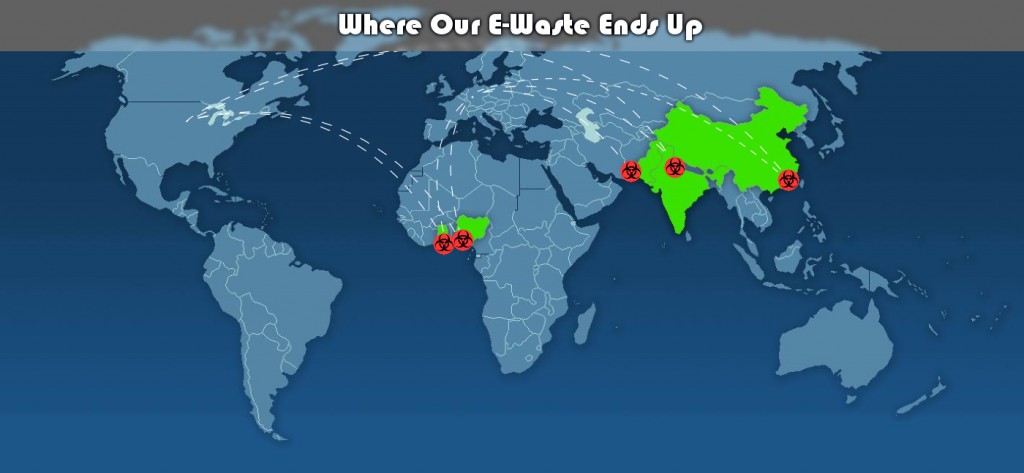Electronic waste or ‘e-waste’ consists of electrical devices or appliances that may be considered non-functional, not needed, outdated, obsolete or electrical products that may have reached the end of their lifespan. With better technology products being introduced, some devices may become ‘trash’ after several years of use.
E-waste is a general term, but it also involves items such as TVs, computers, laptops, tablets, smartphones, and other white goods like refrigerators, washing machines, dryers, home entertainment packages, electronic toys, toasters and electric kettles.
Surprisingly, not all e-waste or discarded devices are not functioning. Some may still be reused, recycled, resold and salvaged, however due to incorrect recycling many of these items are missed and end up in landfill. Any electronic device or appliance used in our homes, offices or what we carry on a day to day basis like cellphones, USBs or laptops can be called e-waste once it loses its value to our daily lives.
Global Issue
We produce a lot of e-waste and the amount created is very alarming. As this trash is sent to landfills, harmful amounts of toxic substances such as lead, mercury and cadmium are expelled into the environment, particularly into the soil and bodies of water located nearby.
 Recent studies have shown that electronic waste has become an environmental challenge worldwide. In the U.S. alone, Americans produce 3.4 million tons of e-waste annually. It’s estimated that over 20 million tons of e-waste are being produced globally. Too much e-waste is being produced each year, but we still fail to confront the problem.
Recent studies have shown that electronic waste has become an environmental challenge worldwide. In the U.S. alone, Americans produce 3.4 million tons of e-waste annually. It’s estimated that over 20 million tons of e-waste are being produced globally. Too much e-waste is being produced each year, but we still fail to confront the problem.
The issue on e-waste is a global concern as each country contributes to the waste level being produced worldwide while the problem is not properly addressed.
Quantifying global e-waste in general is difficult. But we are all aware that large volumes are being thrown in landfills daily where processing of this trash is conducted in a very unsophisticated manner. As a result, this brings potential impact on resource efficiency and the possible dangers to many people around the globe. By engaging different stakeholders and applying scientific systems on the e-waste chain of events, we can start addressing the problem. Involving everyone to take responsibility is a must to fight back the setbacks of e-waste.
E-Waste Benefits
Despite these drawbacks, there may be some benefits from dealing with e-waste. Developing countries are provided access to affordable or low-cost repaired electronics. People are given the opportunity to experience the benefits of technology. Repairing used electronics creates jobs where few opportunities for skilled labor are available.

Many more people will have access to technology through the recycling of dated technology, but even so, the problem still lies in the production of too much e-waste and too little recycling of electronic gadgets.
Responding to the Challenge
Considering e-waste is global concern, everyone can contribute to solve the problem. Initially, we need the experts to teach us how carry out e-waste repair and refurbishment processes. We need to be informed about the different ways to repair our old gadgets or appliances so we can reduce the number of computers or laptops being replaced or thrown away. Repair manuals should also be easier to understand for the user. Having complex instructions adds burden to the gadget owner and pushes him to easily replace his machine.
Teaching the Next Generation
Solving the e-waste problem should start from the grassroots level. Every household has a significant role in combating the issue. Kids, in particular, should be taught the value of reduce, reuse and recycle for their future. Think about the electronic gadgets that may be available at home such as iPads, video games, televisions, cellphones, laptops and other old, operating appliances. When all these gadgets suddenly become ineffective or another appliance with better functions has been bought, these products are being kept and may already be considered e-waste as these devices are no longer needed or may be ready to be disposed.

One way to recycle old smart phones as well as putting some cash in your pocket is through a cellphone buyback company like Sold My Device. They will buyback iPhone, Samsung, LG, and HTC phones from consumers who have upgraded to a newer model and no longer use the older model phones. This is a great way to put these devices into the hands of more people and to keep them out of landfill.
Be Creative with Old Electronics
Don’t throw away old phones and gadgets in the trash. These products usually contain hazardous substances that may be harmful to our environment.
You may have a gadget that you no longer use. Instead of getting rid of it, pass it on to others for reuse. Somebody may find it useful. Give your old, favorite device to a friend who may keep it for daily use. If you can’t find any, donate it for charity in your community. Recycling is another option. Think of innovative ways to use your old gadget!
Revivn is a fantastic initiative that helps enterprises with their old technology by clearing their data and re-purposing the hardware that still has remaining life, providing it to people who lack computer access. These type of recycling start-ups are gaining traction, so keep an eye out for electronic re-purposing companies popping up in your community.

Setting up a cellphone recycling drive as a community fundraising activity could be an interesting activity. Many people have old cellphones that they no longer need and just kept them anywhere around the house. The fund drive is an excellent community project as it helps on a grassroots level. Some of these cell phones may be donated to poor communities or traded to a smartphone recycler where the proceeds will go the community fund.
For some tech-savvy kids, learning to repair broken electronic gadgets can be fun. It only takes some effort and patience to learn how to fix the gadgets. This may also be a part-time venture to let old gadgets function again. Xboxes and iPods can be good starting points. A gadget repair project could also be an exciting school activity.
Next time you’re thinking about buying a new gadget, ask yourself “Do I really need it?” If the answer is “Not really”, and your old Galaxy S5 or modem is still working perfectly, maybe it is worth holding off on that purchase and doing your part to reduce e-waste.












[…] Source: Solving the Growing e-Waste Crisis […]
[…] Source: Solving the Growing e-Waste Crisis […]